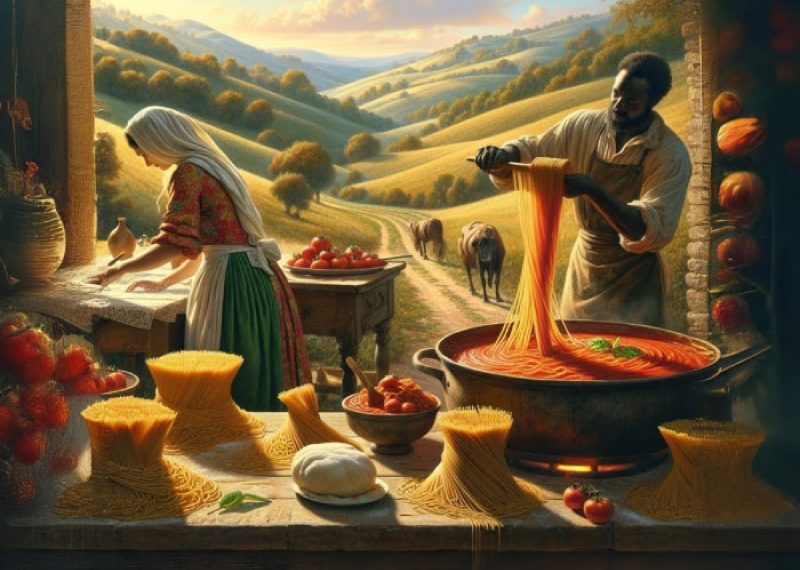THE STORIES OF PASTA
Every dish has a story. A dish shared across cultures often has a journey of discovery, cross-cultural interaction, spread, decline, and rediscovery. Pasta is no different.
The classic narrative we often hear claims that pasta was invented by the Chinese and brought to Italy in the 14th century by Marco Polo. Italians then refined it, diversified it, and made it a hallmark of their cuisine, spreading it globally.
But is this story really accurate?
Could only the Chinese have come up with the idea of grinding wheat, mixing it with water, cutting it, and boiling it – especially during a time when food resources were so limited? Throughout history, many cultures independently developed pasta-like foods.
If we return to the familiar story: Pasta was said to be invented in China during the 1st century CE. Between 960 and 1280, during the Song Dynasty, it gained popularity and dedicated pasta shops opened. However, excavations of Etruscan tombs in Italy – a civilization formed by Trojan and Scythian immigrants – have revealed pasta-making tools dating back to between the 7th and 3rd centuries BCE.
In Roman mythology, Vulcan, the god of fire, is said to have invented a machine that made thin dough strands. In ancient Egyptian murals, foods resembling spaghetti are depicted, and dried noodles were found along the pathways leading to royal tombs.
The renowned philosopher and physician Galen, who lived 2000 years ago in Pergamon, recommended pasta-like food for his patients. Similar dishes existed in Greece, Anatolia, the Middle East, and the Arabian Peninsula. Arab traders traveling through Europe in the 7th century may have introduced a dried, long-lasting dough product known as itriyya.
As we examine individual pasta types, we see that many were discovered at different times. For example, today’s beloved lasagna traces back to Lasana or Lasanum in ancient Rome. Roman food writer Apicius even documented this dish. It was made by layering flat dough strips in a pot called lasanum and baking them in early ovens. England’s first known cookbook, The Form of Cury (1390), also includes a lasagna recipe.
During the Middle Ages, pasta became widespread in Italy due to the country's dry climate (ideal for drying pasta), the religious restrictions against meat during fasting periods, and pasta’s low cost.
Modern pasta production began with the Industrial Revolution. The first licensed pasta factory opened in Venice in 1740. Garofalo, now one of Italy’s biggest pasta producers, was founded in 1789. In the 1800s, water mills were developed to separate semolina from bran. In 1859, Joseph Topits established the first steam-powered pasta factory in Pest, Hungary. By 1867, the Buitoni Company in Sansepolcro, Tuscany became a leading manufacturer.
In 1933, the Braibanti brothers designed and patented the first fully automated pasta-making machine. There’s an interesting link between one of America’s founding fathers, Thomas Jefferson, and Mac & Cheese. During his 1787 trip to Italy, Jefferson noted that the best pasta he tasted was in Naples and that it was made from a special flour called semola. He even sketched a mechanical pasta machine in his notebook and had one shipped to the U.S.
In 1798, the first pasta workshop was opened in Philadelphia. Until then, pasta was an imported luxury. Thanks to Jefferson, it gradually became accessible to the public. He even included pasta in his banquet menus and wrote his own macaroni recipe, which helped spread its popularity.
Jefferson’s cousin Mary Randolph featured the first Mac & Cheese recipe in her cookbook The Virginia Housewife. In 1848, the first industrial pasta factory in the U.S. was opened by a French immigrant. Christian Müller, a German immigrant, began door-to-door pasta sales in 1867 and founded the still-operating Mueller’s pasta brand.
During World War I, the number of pasta factories in the U.S. doubled, partly because Italy banned exports to meet its own needs. Pasta became even more widespread in America during the Great Depression. Kraft Foods introduced boxed Mac & Cheese with the slogan: “Make a meal for four in nine minutes.” The product gained further popularity during WWII when access to fresh dairy was limited. Mac & Cheese became a staple in American households.
There are many contributions to the journey of pasta to decay. Almost every type of pasta has a different story. Pasta is a culture with its historical, traditional and economic dimensions. Pasta, which saves lives with its rich flavor and practical use, will continue its story in the future and will always be in our lives with its new stories.
